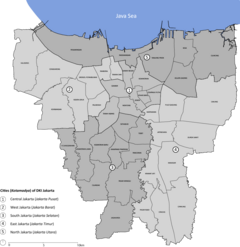
Jakarta Kota Station is a railway station, located in the old city core of Kota, Jakarta, Indonesia.

Gambir Station is a major railway station in Gambir, Gambir, Central Jakarta, Jakarta, Indonesia. The station is located on the eastern side of Merdeka Square and the western side of the Pramuka Movement headquarters and Immanuel Church. It is operated by the KAI.

KRL Commuterline, sometimes shortened as KRL, commonly known as Greater Jakarta Commuter rail, or KRL Jabodetabek is a commuter rail system for Greater Jakarta in Indonesia. It was previously known as KRL Jabodetabek. It is operated by KAI Commuter (KAIC/KCI), a subsidiary of the Indonesian national railway company PT Kereta Api Indonesia (KAI). The rail system uses rolling stock of rapid transit standard and operates at high frequency with a minimum headway. In 2019, the average number of KRL users per day reaches average of 1.04 million, with the record of the highest number of users served in a day being 1,154,080.
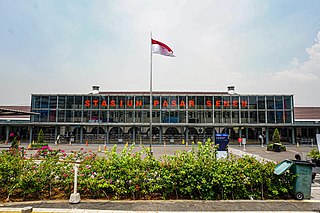
Pasar Senen Station (PSE) is a railway station located in Jakarta, Indonesia. It is the second largest railway station in Jakarta after Gambir Station. It is located close to Pasar Senen market area in Senen, Senen, Central Jakarta. The current building was built in 1918 and inaugurated on 19 March 1925.

Jatinegara Station (JNG) is a large type A-class railway station located on the border between Jatinegara and Matraman in Pisangan Baru Subdistrict, Matraman, East Jakarta. The station is the main entrance to Jakarta from cities east of Jakarta. Jatinegara station is operated by Kereta Api Indonesia and KAI Commuter.

Depok Station (DP) is a railway station located in Pancoran Mas, Pancoran Mas, Depok, West Java. This station is commonly known as Depok Lama, to distinguish with Depok Baru Station. The station is one of the oldest station in Jakarta metropolitan area. At present it serves as a station of Jakarta Commuter Rail. Depok EMU depot is located to the southwest of the station.
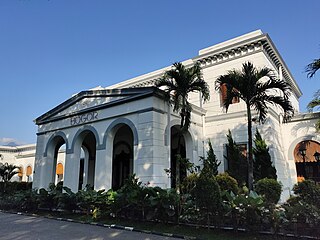
Bogor Station (BOO), formerly Buitenzorg Station, is a railway station located in the city of Bogor, West Java. This station serves as the terminus for the Red Line service of KRL Commuterline. The station has five island platforms and two side platforms. The station is located +246 meter above sea level.

Bekasi Station (BKS) is a railway station located in Marga Mulya, North Bekasi, Bekasi, West Java. The station is at an altitude of +19 meters above sea level. This station serves the KRL Commuterline and inter-city trains.

Manggarai Station (MRI) is a railway station at Manggarai, Tebet, South Jakarta, Jakarta, Indonesia. At present, it serves primarily as a transit station for KRL Commuterline's Bogor Line, Cikarang Loop Line, and Soekarno–Hatta Airport Rail Link; The Bukit Duri depot is located at the south side of the station, it also serves as a storage for intercity trains before they go to Gambir or Jakarta Kota stations for their departure.

Tanah Abang Station (THB) is a railway station located in Kampung Bali, Tanah Abang, Central Jakarta, Jakarta, Indonesia. The station located to the east of West Flood Canal, and serves Rangkasbitung and Cikarang Loop lines of KRL Commuterline. The station and the canal are only separated by a small, narrow embankment and as such, Tanah Abang station is prone to flooding, especially during the heavy rain season.

Duri Station (DU) is a railway station located in West Jakarta. It serves as the starting point and the eastern terminus of the Tangerang Line service. The station is a major transfer point for commuters to or from Tangerang. When the Jakarta Kota-Manggarai railway is disrupted, trains between Jakarta Kota and Manggarai are rerouted via Duri.
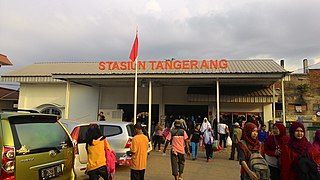
Tangerang Station is a railway station located in the city of Tangerang, Banten. It is the western terminus of the Duri–Tangerang railway. This station only serves commuter trains operated by Kereta Commuter Indonesia. Passengers are mainly commuters going from the suburbs in Tangerang to Jakarta.

Kampung Bandan Station (KPB) is a railway station located in North Jakarta. This station is located close to WTC Mangga Dua. This station has elevated and ground-level tracks. The elevated level tracks are used by trains between Jakarta Kota and Tanjung Priuk, as the Tanjung Priuk Line. The ground tracks are used by trains going to Cikarang as the Cikarang Loop Line. This station has been hit by floods numerous times.

The Cikarang Loop Line, officially the Cikarang Commuter Line, is a commuter rail line in Jakarta, Indonesia which is operated by PT Kereta Commuter Indonesia (KCI). The line connects Kampung Bandan station in North Jakarta and Cikarang station in Cikarang, Bekasi Regency, West Java. On maps and diagrams, the line is shown using the color "blue". Jakarta Kota–Cikarang is the extension of previously Jakarta Kota–Bekasi line which connects to Cikarang since 8 October 2017.
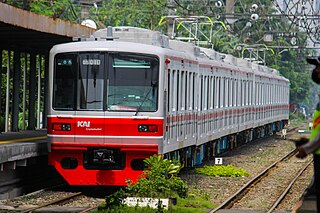
The Tanjung Priok Line, officially the Tanjung Priok Commuter Line, is a commuter rail line in Indonesia, operated by PT Kereta Commuter Indonesia. The line connects Jakarta Kota station in West Jakarta and Tanjung Priuk station in North Jakarta. On maps and diagrams, the line is shown using the colour "pink". Covering a distance of only 8.115 kilometres, the pink line is the shortest line in the Jakarta KA Commuter system, and serves mostly as the connecting feeder line between Jakarta Kota station and Kampung Bandan station. The Pink Line traces its origins back to a railway line built from 1883–1885 during the Dutch colonial era, to connect the city of Jakarta to Tanjung Priok Port. It was also one of the earliest railway lines in Indonesia to be electrified starting from 1925.

Juanda Station is a railway station located in Kebon Kelapa, Gambir, Central Jakarta, Jakarta, Indonesia. Since Gambir station stopped serving Commuterline trains, Juanda, along, with Gondangdia station, has become the alternative for passengers going to Merdeka Square and the surrounding areas. It is also located near the Istiqlal Mosque.
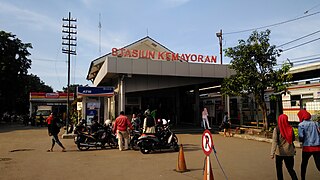
Kemayoran Station (KMO) is a railway station located at South Gunung Sahari, Kemayoran, Central Jakarta, Indonesia. This station is located between Pasar Senen railway station in the south and Rajawali railway station in the north. The station is a stoppage for Jakarta metro commuter rail.

Cikampek Station (CKP) is a large class type B railway station located in Cikampek Kota, Cikampek, Karawang Regency. The station, which is located at an altitude of +46 meters, is the station that is located in the easternmost part of the Operational Area I Jakarta and Karawang Regency, and is the largest railway station in Karawang Regency.

Purwakarta Station (PWK) is a class I railway station located in Nagritengah, Purwakarta, Purwakarta Regency. The station, which is located at an altitude of +84 meters, is included in the Operational Area II Bandung. This station is located very close to the Purwakarta regent's office which can be reached on foot.
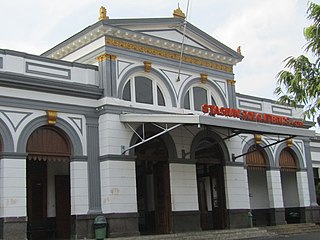
Solo Jebres Station, also known as Jebres Station, is a type-C large class railway station in Surakarta, Central Java, Indonesia. The station, which is located 97 metres (318 ft) above sea level, is operated by Operational Area VI Yogyakarta of Kereta Api Indonesia (KAI). It is one of the major railway stations in the city.


